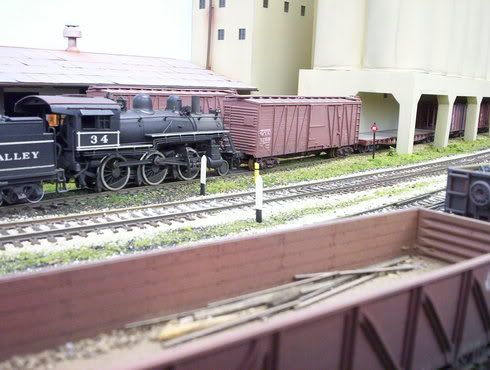Thanks for the compliment, farnham. I don't think that railroads did specific cleaning of freight car exteriors, partly because of the cost involved, and partly because many freight cars spend a lot of time off-line: that is, in service on another railroad. Even a car damage in service on a line other than the owner's is repaired by the road on whose line the damage occurred, with an appropriate bill sent to the owning road. Paint would be touched-up as required, usually with paint that is close in colour to the original, unless, of course, the car is not a common colour. That's one reason why we used to see a lot of black or boxcar red patch areas on those jade green cars of the Penn Central. In any case, the owning road, or at least the people on that road who would be responsible for doing cleaning or repainting, probably wouldn't see these cars unless they were brought in to have some specific work done on them, and even then, the work to be done would more likely to be of a mechanical nature, intended to keep the car in service.
Another good way to show age and use on a freight car is to add either reweigh or repack data, even on cars that you've had in service on your layout for years. Champ makes sets to do cars from all over North America. Simply select the data that you wish to use, paint a suitably-sized patch of paint in an appropriate spot on the car side, and apply the lettering. You can use a colour similar to the colour of the car, but cleaner of course, or a contrasting colour, as I did on this gondola, for repack data.

You can also get this effect on a new car by masking off a suitable area before weathering, then removing the masking and applying the data on the "clean" patch.
And finally: the Niagara Peninsula is the area of southern Ontario across from what Americans call the Niagara Frontier. It's the area of Ontario that lies between Lake Erie and Lake Ontario.
Wayne
Another good way to show age and use on a freight car is to add either reweigh or repack data, even on cars that you've had in service on your layout for years. Champ makes sets to do cars from all over North America. Simply select the data that you wish to use, paint a suitably-sized patch of paint in an appropriate spot on the car side, and apply the lettering. You can use a colour similar to the colour of the car, but cleaner of course, or a contrasting colour, as I did on this gondola, for repack data.

You can also get this effect on a new car by masking off a suitable area before weathering, then removing the masking and applying the data on the "clean" patch.
And finally: the Niagara Peninsula is the area of southern Ontario across from what Americans call the Niagara Frontier. It's the area of Ontario that lies between Lake Erie and Lake Ontario.
Wayne











